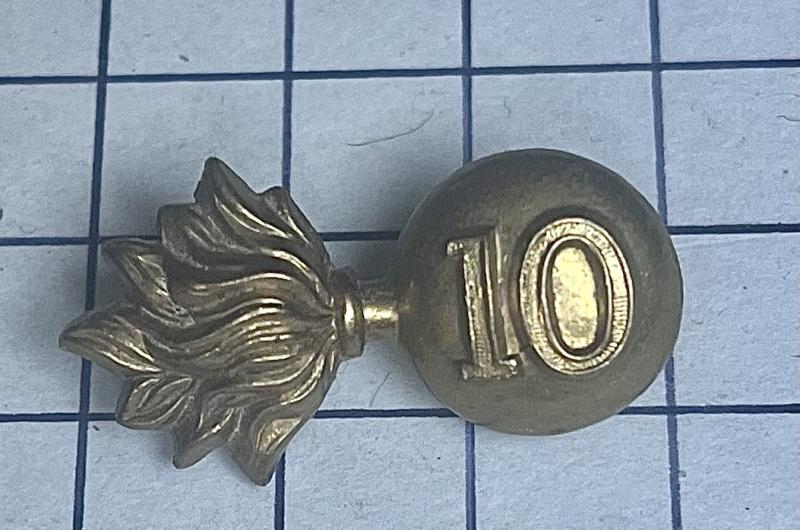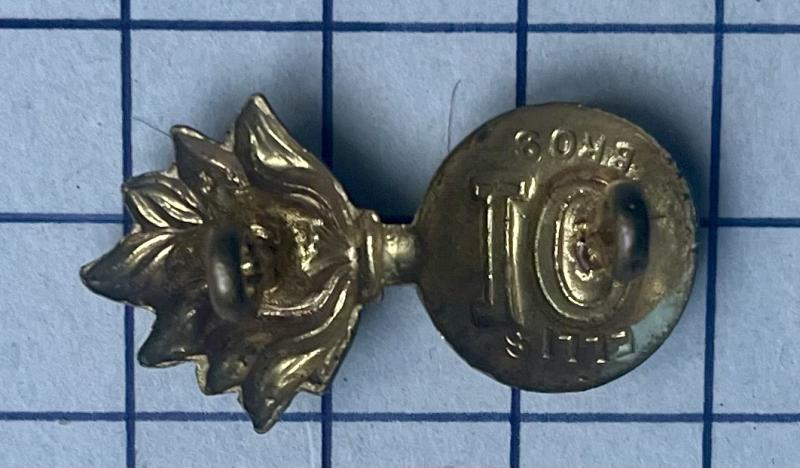Canadian Canada Militia 10th Battalion of Royal Grenadiers Gilding Metal Collar Badge
Pre-1936, Canadian Militia 10th Bn Royal Grenadiers – Gilding Metal Collar Badge. Maker marked 'ELLIS BROS'. VGC.
Fenian Raids
The 10th or Royal Regiment of Toronto Volunteers was called out on active service from 8 to 31 March and from 1 to 22 June 1866. The battalion served on the Niagara frontier and took part in the mopping-up operations after the disastrous Battle of Ridgeway.
1880s
On 5 August 1881, the regiment was re-designated as the 10th Battalion Royal Grenadiers. At the time, this unit was the only other regiment of its type in the entire British Empire: the other regiment being The Grenadier Guards.
North-West Rebellion
On 27 March 1885, the 10th Battalion Royal Grenadiers was called to arms and turned out in marching order the following day. The battalion served with General Middleton's column of the North West Field Force, until they returned from active service on 24 July 1885. The 10th Royal Grenadiers saw action at the Battle of Fish Creek (24 April), and the Battle of Batoche (9–12 May), serving with distinction during the campaign and earning the regiment its first battle honours.
South African War and early 1900s
During the Second Boer War, the 10th Battalion Royal Grenadiers contributed volunteers for the 2nd (Special Service) Battalion, The Royal Canadian Regiment of Infantry.
As a part of the country-wide reorganisation of the Canadian Militia at the start of the 20th century, on 8 May 1900, the regiment was re-designated as the 10th Regiment, Royal Grenadiers.
Great War
On 6 August 1914, details of the 10th Royal Grenadiers were placed on active service for local protection duties.
When the Canadian Expeditionary Force was raised, the 10th Royal Grenadiers contributed drafts to help raise the 3rd Battalion (Toronto Regiment), CEF alongside those from The Queen's Own Rifles of Canada and The Governor General's Body Guard.
On 20 April 1915, the 58th Battalion, CEF, was authorized for service and on 22 November 1915, the battalion embarked for Great Britain. After its arrival in Europe, on 22 February 1916, the 58th Battalion disembarked in France, where it fought as part of the 9th Canadian Brigade, 3rd Canadian Division, in France and Flanders until the end of the war. On 15 September 1920, the 58th Battalion, CEF was disbanded.
On 22 December 1915, the 123rd Battalion (Royal Grenadiers), CEF was authorized for service and from 7 to 8 August 1916, the battalion embarked for Great Britain. On 17 January 1917, the battalion was converted to a pioneer battalion and redesignated as the 123rd Canadian Pioneer Battalion, Royal Grenadiers, CEF. On 10 March 1917, the battalion disembarked in France where it served as the pioneer battalion of the 3rd Canadian Division in France and Flanders. On 25 May 1918, the battalion was reorganized to form three new engineering battalions; the 7th, 8th and 9th Canadian Engineer Battalions, CEF. On 15 September 1920, the 123rd Battalion, CEF was disbanded.
1920s–1930sedit
On 15 March 1920, as a result of the Otter Commission and the following post-war reorganisation of the militia, the 10th Regiment Royal Grenadiers was re-designated as The Royal Grenadiers and was reorganised with two battalions (one of them a paper-only reserve battalion) to perpetuate the assigned war-raised battalions of the Canadian Expeditionary Force.
As a result of the 1936 Canadian Militia reorganization, on 15 December 1936, The Royal Grenadiers was amalgamated with The Toronto Regiment to form The Royal Regiment of Toronto Grenadiers (now The Royal Regiment of Canada).
Code: 1149
25.00 GBP


